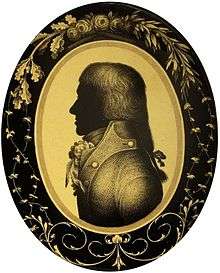Verre églomisé

Verre églomisé, from the French term meaning gilded glass, is a decorative technique in which the back side of glass is gilded with gold or metal leaf.
In one of a number of related processes, the metal is fixed using a gelatin adhesive, which results in a mirror-like, reflective finish in which designs are then engraved. The metal leaf may be applied using oil-based adhesives (goldsize varnish) to achieve a matte finish. The gilding may also be combined with reverse painting on glass. It is to be distinguished from "sandwiched" gold glass where gold leaf is glued to a piece of glass, and often then scraped off to form a design, and a further layer of hot glass is then applied on top and fused to seal the gold inside.
The technique dates back to the pre-Roman eras, but its name is derived from 18th-century French decorator and art-dealer Jean-Baptiste Glomy (1711–1786), who is responsible for its revival.
One of the key historical periods of the art was in Italy during the 13th to 16th centuries. Small panels of glass with designs formed by engraved gilding were applied to reliquaries and portable altars. The method used is described by Cennino Cennini.
It has also been used throughout Europe since the 15th century, appearing in paintings, furniture, drinking glasses and similar vessels and jewelry. It is also often seen in the form of decorative panels of mirrors, clock faces, and in more recent history, as window signs and advertising mirrors.
Practitioners include Jonas Zeuner and Hans Jakob Sprungli (1559–1637).
Modern variations can be found as new materials become available to artisans. J. Kenton Manning (b. 1958-) A former painting techniques instructor at UCI (1985) taught reverse painting on glass as well as painting on celluloid, a popular technique in the animation industry. In his fine art, produced in the 21st century, he creates Mandalas and abstracts using metallic and iridescent paints reverse painted on Plexiglas, which produces a similar gilded effect. These draw an interesting connection between the old world spiritual subject matter and modernist abstract techniques and materials. Like traditional verre églomisé, proper direct lighting is essential to produce the artist's intended effect.
External links
- goldreverre, detailed explanation of techniques used in verre églomisé
- verre églomisé example on a painted screen/room divider (top left).